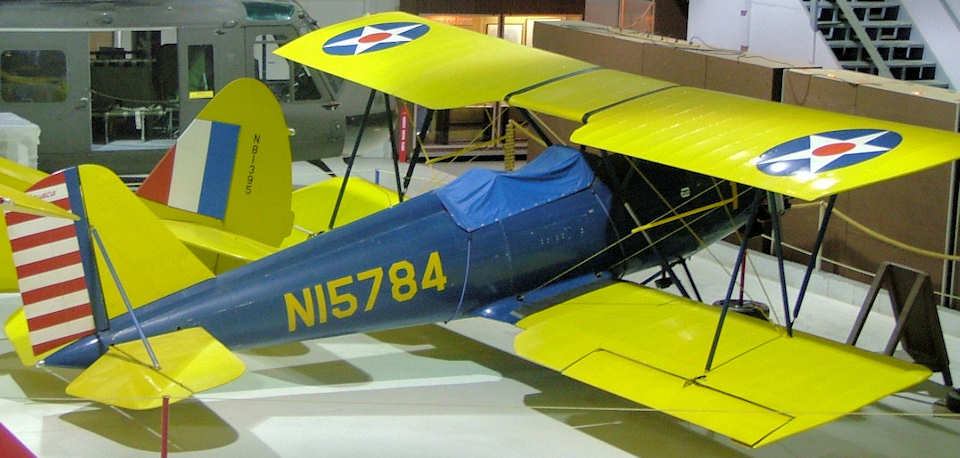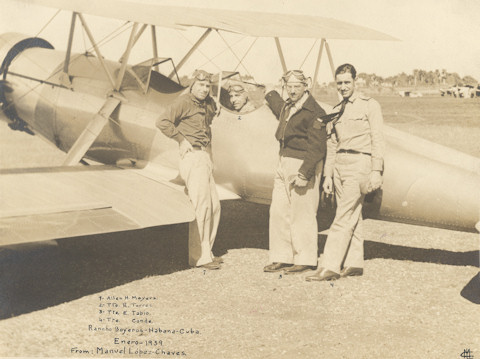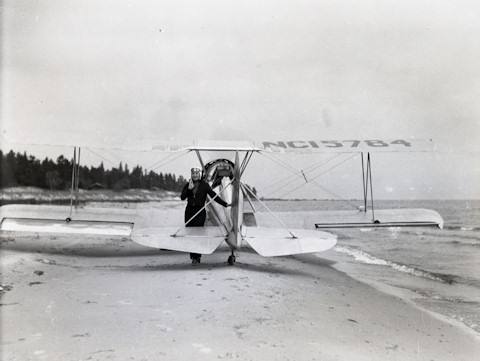This is the oldest aircraft in our collection. It never served in the US military, but it did train future military pilots under the pre-World War II Civil Pilot’s Training Program (CPTP) and its successor, the War Training Service (WTS).
Our OTW is the original. It proudly displays the serial number "1" on either side of the forward fuselage. Designed and built by Allen H. Meyers, the letters "OTW" stood for "Out To Win". The design originated in 1930, and Meyers began construction of the plane September 3, 1933, in a car garage in Wayne, Michigan. During the fall of 1934, a friend, Jimmy Keehl, invited Meyers to move the project to his father’s foundry machine shop in Romulus, Michigan at the Wayne County Airport (now the site of Detroit Metropolitan Wayne County Airport). The aircraft had an all metal, semi-monocoque fuselage with fabric-covered wings with spruce spars. The tail group was a fabric-covered steel tube structure. It was powered by a 125 hp (93.2kW) Warner Scarab seven-cylinder, air-cooled, radial engine. Production on the plane was completed in 1935.
The first test flight of this aircraft occurred at Wayne County Airport at 4 p.m. on May 10, 1936, with the test flight being covered by the Detroit News. The testing took some nine hours, at which time Meyers had to fly in the newly tested OTW to New York to attend to his mother who had been burned in a fire. Meyers took off in the just-tested aircraft and, according to the newspapers, both patient and OTW #1 made it through.
OTW serial numbers 1 and 2 were built in the Romulus foundry. In 1939, Meyers moved his construction to Tecumseh, Michigan. The last OTW, serial number 102, was delivered in 1943.
Meyers flew OTW #1 from 1936 through at least May 28, 1939 and took it out of the United States a few times. The aircraft’s log book shows flights to Ottawa, Quebec, Canada in September 1938; London, Ontario, in November 1938; and Havana, Cuba in January 1939 (see photo below).
Sometime after May 1939, the OTW was pressed into service by the US government. In the years immediately prior to World War II, several European countries, particularly Nazi Germany and Fascist Italy trained thousands of pilots. In response, the US recognized a need to also train large numbers of pilots. In order to meet this demand, President Franklin Roosevelt enacted the Civilian Pilot Training Program (CPTP) on December 27, 1938. Under this program the government contracted with many private flying schools across the United States to train college students as pilots. Initial aircraft types approved for the CPTP included the Ryan PT-22, WACO UPF, and Meyers OTW. Piper Cub, Aeronca, and Taylorcraft were also used.
Our records on NC15784 are incomplete. We do not know when it entered the CPTP, but it did so at John Brown University (JBU), Siloam Springs, Arkansas. The University’s archives indicate the OTW was one of the second pair of aircraft purchased for the CPTP in 1939-1940 but there are conflicting documents when it comes to the actual date of acquisition. One of our log books shows that it was at JBU by at least December 29, 1942.
After the US entry into World War II the CPTP became the War Training Service. The CPTP/WTS was phased out in the summer of 1944, and this is reflected in the OTW’s flight log. The plane flew only six months in 1944, a total of 1 hour 55 minutes in 1945, and not at all in 1946. After 1946, the Meyers underwent several private owners, including a period as a crop duster in the Wichita, Kansas area.
In 1965 Mr. Delbert L. Denly of Osceola, Iowa purchased N15784 and restored the aircraft back to its original configuration but with a 165 hp (123kW) Warner Super Scarab engine. In 1980, Mr. Ralph Knehans, a Museum member and volunteer, met Mr. Denly with his plane and from there began a lasting friendship until Mr. Denly’s death in December 1985. Prior to his death, Mr. Denly told Ralph he was putting the OTW up for sale, and after approval from CAM’s Board of Directors, Ralph became project manager to raise funds to purchase the Meyers. In fact, Ralph launched a virtual one-man campaign to successfully raise funds from museum members and citizens and businesses of the Topeka community so CAM could purchase N15784. The transfer of ownership took place in August 1986, and the OTW flew into Forbes Field on September 14, 1986.
This aircraft is owned by Combat Air Museum.







